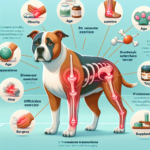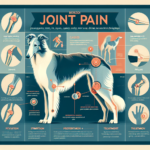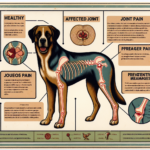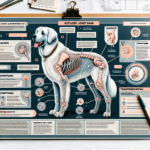English Foxhound Joint Pain: Causes, Symptoms, Prevention, and Treatment
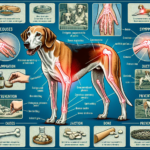
Introduction
The English Foxhound is a distinguished breed known for its endurance, agility, and keen sense of smell. Originating in England, this breed was developed in the 16th century primarily for hunting foxes. English Foxhounds are characterized by their muscular build, short coat, and friendly demeanor. They are pack animals, often working in groups during hunts, and are known for their stamina and ability to cover large distances.
While English Foxhounds are generally robust and healthy, they are not immune to certain health issues. Common concerns include ear infections, eye problems, and most notably, joint pain. Joint health is particularly crucial for this breed due to their high activity levels and the physical demands placed on their bodies during hunting and other activities.
Breed-Specific Joint Pain Risks
Genetic Predisposition
English Foxhounds, like many other breeds, are genetically predisposed to certain joint-related issues. Hip dysplasia, a condition where the hip joint does not fit into the hip socket properly, is relatively common. This can lead to arthritis and significant pain over time. Elbow dysplasia, another genetic condition, affects the elbow joint and can cause similar issues. Both conditions are hereditary, meaning that they can be passed down from one generation to the next.
Age-Related Risks
As English Foxhounds age, the risk of developing joint pain increases. The breed typically shows signs of aging around 7 to 9 years old. During this time, the cartilage that cushions the joints can wear down, leading to arthritis. Older dogs may also experience decreased muscle mass, which can further exacerbate joint issues.
Activity Level and Joint Stress
English Foxhounds are highly active dogs, often used in hunting and other physically demanding activities. This high level of activity can put significant stress on their joints, especially if they are not given adequate rest or if they are overworked. The repetitive motion of running and jumping can lead to wear and tear on the joints, making them more susceptible to injury and pain.
Common Symptoms of Joint Pain in English Foxhounds
General Symptoms
- Limping: One of the most noticeable signs of joint pain is limping or favoring one leg over another.
- Stiffness: Dogs may show stiffness, especially after resting or sleeping.
- Reluctance to Move: A dog in pain may be reluctant to engage in activities they once enjoyed, such as running or climbing stairs.
- Swelling: Joints may appear swollen or feel warm to the touch.
- Behavioral Changes: Dogs may become irritable or show signs of discomfort when touched.
Breed-Specific Symptoms
In English Foxhounds, joint pain may manifest as a reluctance to participate in hunting or other high-energy activities. They may also show a decrease in stamina and endurance, which is unusual for this typically energetic breed. Owners should be particularly vigilant for these signs, as they can indicate the onset of joint issues.
When to Consult a Vet
If you notice any of the above symptoms in your English Foxhound, it is crucial to consult a veterinarian. Early diagnosis and treatment can significantly improve the quality of life for your dog. Persistent limping, noticeable swelling, or any sudden changes in behavior should prompt an immediate visit to the vet.
Preventive Measures for Joint Health
Exercise Recommendations
Regular, moderate exercise is essential for maintaining joint health in English Foxhounds. Activities such as walking, swimming, and controlled running can help keep the joints flexible and muscles strong. Avoid high-impact activities like jumping or running on hard surfaces, as these can exacerbate joint issues.
Dietary Suggestions
A balanced diet rich in essential nutrients can support joint health. Foods high in omega-3 fatty acids, such as fish oil, can reduce inflammation. Supplements like glucosamine and chondroitin can also help maintain cartilage health. Always consult your vet before adding any supplements to your dog’s diet.
Weight Management
Maintaining a healthy weight is crucial for reducing stress on the joints. Overweight dogs are more likely to develop joint issues due to the extra pressure on their joints. Regular exercise and a balanced diet can help keep your English Foxhound at an optimal weight.
Early Screening and Monitoring
Regular veterinary check-ups are essential for early detection of joint issues. Screening tests such as X-rays can help identify problems before they become severe. Monitoring your dog’s activity levels and behavior can also provide early clues to potential joint issues.
Treatment Options for Joint Pain
Non-Surgical Treatments
Non-surgical treatments for joint pain include medications such as non-steroidal anti-inflammatory drugs (NSAIDs) to reduce pain and inflammation. Physical therapy can also be beneficial, helping to strengthen the muscles around the joints and improve flexibility. Lifestyle adjustments, such as providing a comfortable bed and avoiding stairs, can also help manage pain.
Surgical Options
In severe cases, surgical intervention may be necessary. Common surgeries for joint pain include hip replacement, arthroscopy to remove damaged tissue, and joint fusion. These procedures can significantly improve the quality of life for dogs with severe joint issues, but they come with risks and require a lengthy recovery period.
Alternative Therapies
Alternative treatments such as acupuncture, hydrotherapy, and massage can also provide relief from joint pain. Acupuncture can help reduce pain and inflammation, while hydrotherapy allows for low-impact exercise that can strengthen muscles without stressing the joints. Massage can improve circulation and reduce muscle tension.
Lifestyle and Management Tips
Daily Care Routine
A daily care routine for an English Foxhound with joint pain should include gentle exercise, a balanced diet, and regular vet check-ups. Providing a comfortable, supportive bed and avoiding activities that put stress on the joints can also help manage pain.
Modifying the Home Environment
Making your home more comfortable for a dog with joint pain can significantly improve their quality of life. Consider installing ramps to help them navigate stairs, providing orthopedic beds for better support, and using non-slip mats to prevent falls.
Long-Term Management
Long-term management of joint pain involves regular monitoring and adjustments to your dog’s care routine as needed. Keeping your dog active, maintaining a healthy weight, and providing a supportive environment can help them live a happy, comfortable life despite joint issues.
FAQs About English Foxhounds and Joint Pain
What are the early signs of joint pain in English Foxhounds?
Early signs include limping, stiffness, reluctance to move, and behavioral changes such as irritability.
Can joint pain in English Foxhounds be prevented?
While it may not be entirely preventable, maintaining a healthy weight, providing regular exercise, and early screening can help reduce the risk.
Are there specific diets that can help with joint health?
Yes, diets rich in omega-3 fatty acids and supplements like glucosamine and chondroitin can support joint health.
When should I consult a vet about my dog’s joint pain?
If you notice persistent limping, swelling, or any sudden changes in behavior, consult a vet immediately.
Conclusion
Joint health is a critical aspect of overall well-being for English Foxhounds. By understanding the causes, symptoms, and preventive measures, owners can take proactive steps to ensure their dogs remain healthy and active. Regular veterinary check-ups, a balanced diet, and appropriate exercise are key components in managing and preventing joint pain. Always consult your veterinarian for personalized advice and treatment options to keep your English Foxhound happy and comfortable.

